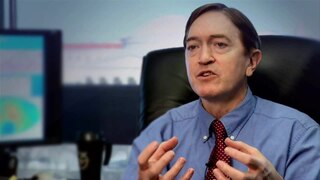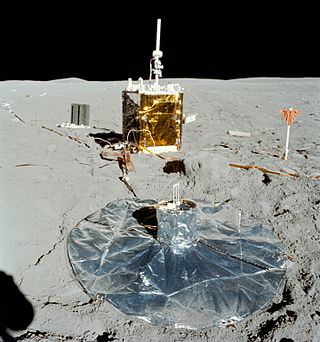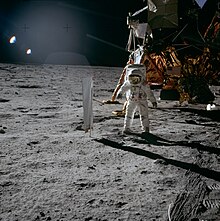
Apollo 12 was the sixth crewed flight in the United States Apollo program and the second to land on the Moon. It was launched on November 14, 1969, by NASA from the Kennedy Space Center, Florida. Commander Charles "Pete" Conrad and Lunar Module Pilot Alan L. Bean performed just over one day and seven hours of lunar surface activity while Command Module Pilot Richard F. Gordon remained in lunar orbit.

Apollo 16 was the tenth crewed mission in the United States Apollo space program, administered by NASA, and the fifth and penultimate to land on the Moon. It was the second of Apollo's "J missions", with an extended stay on the lunar surface, a focus on science, and the use of the Lunar Roving Vehicle (LRV). The landing and exploration were in the Descartes Highlands, a site chosen because some scientists expected it to be an area formed by volcanic action, though this proved not to be the case.

Earth is the third planet from the Sun and the only astronomical object known to harbor life. This is enabled by Earth being a water world, the only one in the Solar System sustaining liquid surface water. Almost all of Earth's water is contained in its global ocean, covering 70.8% of Earth's crust. The remaining 29.2% of Earth's crust is land, most of which is located in the form of continental landmasses within Earth's land hemisphere. Most of Earth's land is somewhat humid and covered by vegetation, while large sheets of ice at Earth's polar deserts retain more water than Earth's groundwater, lakes, rivers and atmospheric water combined. Earth's crust consists of slowly moving tectonic plates, which interact to produce mountain ranges, volcanoes, and earthquakes. Earth has a liquid outer core that generates a magnetosphere capable of deflecting most of the destructive solar winds and cosmic radiation.

The Moon is Earth's only natural satellite. It orbits at an average distance of 384,400 km (238,900 mi), about 30 times the diameter of Earth. Over time Earth's gravity has caused tidal locking, causing the same side of the Moon to always face Earth. Because of this, the lunar day and the lunar month are the same length, at 29.5 Earth days. The Moon's gravitational pull – and to a lesser extent, the Sun's – are the main drivers of Earth's tides.

Clementine was a joint space project between the Ballistic Missile Defense Organization and NASA, launched on January 25, 1994. Its objective was to test sensors and spacecraft components in long-term exposure to space and to make scientific observations of both the Moon and the near-Earth asteroid 1620 Geographos.

Huygens was an atmospheric entry robotic space probe that landed successfully on Saturn's moon Titan in 2005. Built and operated by the European Space Agency (ESA), launched by NASA, it was part of the Cassini–Huygens mission and became the first spacecraft to land on Titan and the farthest landing from Earth a spacecraft has ever made. The probe was named after the 17th-century Dutch astronomer Christiaan Huygens, who discovered Titan in 1655.

Lunar Prospector was the third mission selected by NASA for full development and construction as part of the Discovery Program. At a cost of $62.8 million, the 19-month mission was designed for a low polar orbit investigation of the Moon, including mapping of surface composition including lunar hydrogen deposits, measurements of magnetic and gravity fields, and study of lunar outgassing events. The mission ended July 31, 1999, when the orbiter was deliberately crashed into a crater near the lunar south pole, after the presence of hydrogen was successfully detected.

Chandrayaan-1 was the first Indian lunar probe under the Chandrayaan programme. It was launched by the Indian Space Research Organisation (ISRO) in October 2008, and operated until August 2009. The mission included an orbiter and an impactor. India launched the spacecraft using a PSLV-XL rocket on 22 October 2008 at 00:52 UTC from Satish Dhawan Space Centre, at Sriharikota, Andhra Pradesh. The mission was a major boost to India's space program, as India researched and developed indigenous technology to explore the Moon. The vehicle was inserted into lunar orbit on 8 November 2008.

The geology of the Moon is quite different from that of Earth. The Moon lacks a true atmosphere, and the absence of free oxygen and water eliminates erosion due to weather. Instead, the surface is eroded much more slowly through the bombardment of the lunar surface by micrometeorites. It does not have any known form of plate tectonics, it has a lower gravity, and because of its small size, it cooled faster. In addition to impacts, the geomorphology of the lunar surface has been shaped by volcanism, which is now thought to have ended less than 50 million years ago. The Moon is a differentiated body, with a crust, mantle, and core.

Apollo 15 lunar surface operations were conducted from July 30 to August 2, 1971, by Apollo 15 Commander David Scott and Apollo Lunar Module Pilot James Irwin, who used the first Lunar Roving Vehicle to make three exploratory trips away from their landing site at the base of the Apennine Mountains, near Hadley Rille.

During the 1971 Apollo 15 mission to the Moon, and its three days of exploration on the lunar surface by David Scott and James Irwin, Command Module Pilot (CMP) Al Worden had a busy schedule of observations. Apollo 15 was the first mission to carry the Scientific Instrument Module (SIM) bay, which contained a panoramic camera, gamma ray spectrometer, mapping camera, laser altimeter and mass spectrometer. Worden had to operate the shutter and lenses on the cameras and turn on and off the various instruments. During the coast back to Earth, he would perform an EVA to retrieve film cassettes from the cameras.

The Global Geospace Science (GGS) Wind satellite is a NASA science spacecraft designed to study radio waves and plasma that occur in the solar wind and in the Earth's magnetosphere. It was launched on 1 November 1994, at 09:31:00 UTC, from launch pad LC-17B at Cape Canaveral Air Force Station (CCAFS) in Merritt Island, Florida, aboard a McDonnell Douglas Delta II 7925-10 rocket. Wind was designed and manufactured by Martin Marietta Astro Space Division in East Windsor Township, New Jersey. The satellite is a spin-stabilized cylindrical satellite with a diameter of 2.4 m and a height of 1.8 m.

Lunar habitation is any long-term activity on the Moon, establishing human habitation on the Moon. Therefore, it is more than the particular surface space habitats and more specific than the moonbases which can consist of any facility.

Lunar soil is the fine fraction of lunar regolith found on the surface of the Moon and contributes to the Moon's tenuous atmosphere. Lunar soil differs in its origin and properties significantly from terrestrial soil.

The magnetic field of the Moon is very weak in comparison to that of the Earth; the major difference is the Moon does not have a dipolar magnetic field currently, so that the magnetization present is varied and its origin is almost entirely crustal in location; so it's difficult to compare as a percentage to Earth. But, one experiment discovered that lunar rocks formed 1 - 2.5 billion years ago were created in a field of about 5 microtesla (μT), compared to present day Earth's 50 μT. During the Apollo program several magnetic field strength readings were taken with readings ranging from a low of 6γ (6nT) at the Apollo 15 site to a maximum of 313γ (0.31μT) at the Apollo 16 site, note these readings were recorded in gammas(γ) a now outdated unit of magnetic flux density equivalent to 1nT.
John Hoffman was a space scientist who developed instruments for Apollo 15, Apollo 16, Apollo 17, the Pioneer Venus project, and Giotto mission. He also designed the mass spectrometer for the Phoenix Mars Lander mission in May 2008. He was a professor of physics at the University of Texas at Dallas.

The Swiss Space Office (SSO) is the federal government's competence centre for national and international space matters. In its role it cooperates closely with other federal offices and is responsible for the preparation and implementation of the policy and strategic orientations of the space domain in Switzerland. The SSO is part of the State Secretariat for Education, Research, and Innovation. The Head of the SSO is Dr. Renato Krpoun.

The Apollo Lunar Surface Experiments Package (ALSEP) comprised a set of scientific instruments placed by the astronauts at the landing site of each of the five Apollo missions to land on the Moon following Apollo 11. Apollo 11 left a smaller package called the Early Apollo Scientific Experiments Package, or EASEP.

The Moon bears substantial natural resources which could be exploited in the future. Potential lunar resources may encompass processable materials such as volatiles and minerals, along with geologic structures such as lava tubes that, together, might enable lunar habitation. The use of resources on the Moon may provide a means of reducing the cost and risk of lunar exploration and beyond.

The Solar Wind Spectrometer was a scientific package that flew on the Apollo 12 and Apollo 15 missions to the surface of the Moon. The goal was to characterise the solar wind near the Moon's surface and to explore its interactions with the lunar environment. The experiments' principal investigator was Dr Conway W. Snyder of the Jet Propulsion Laboratory.


















